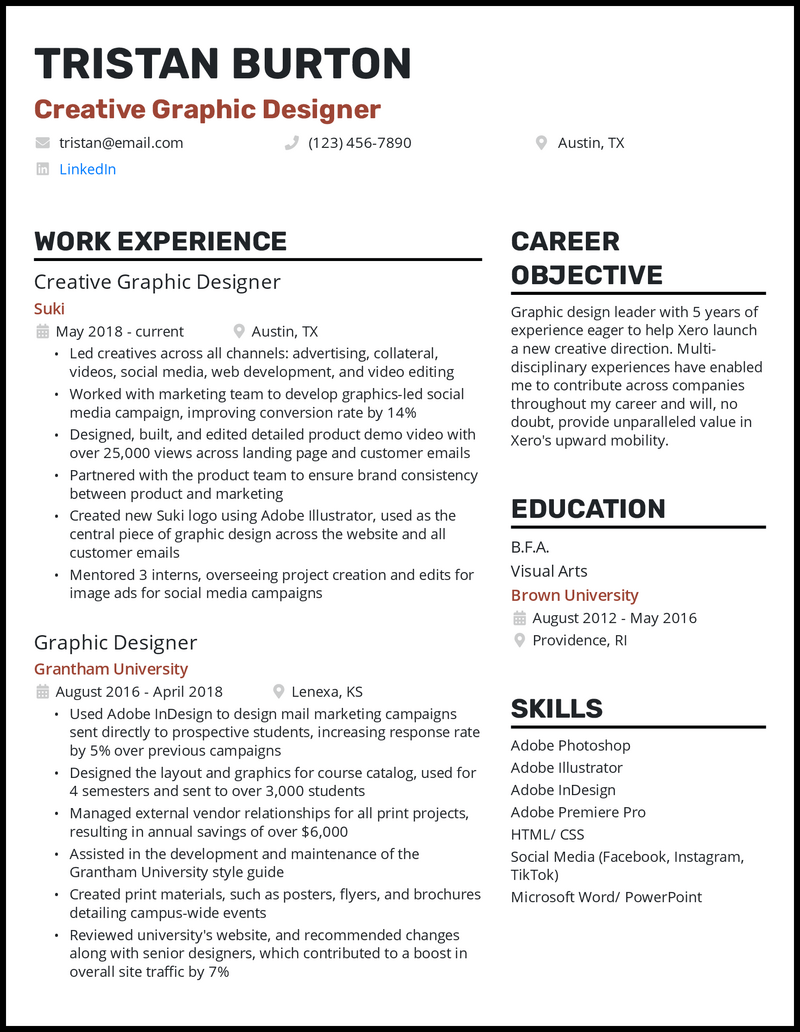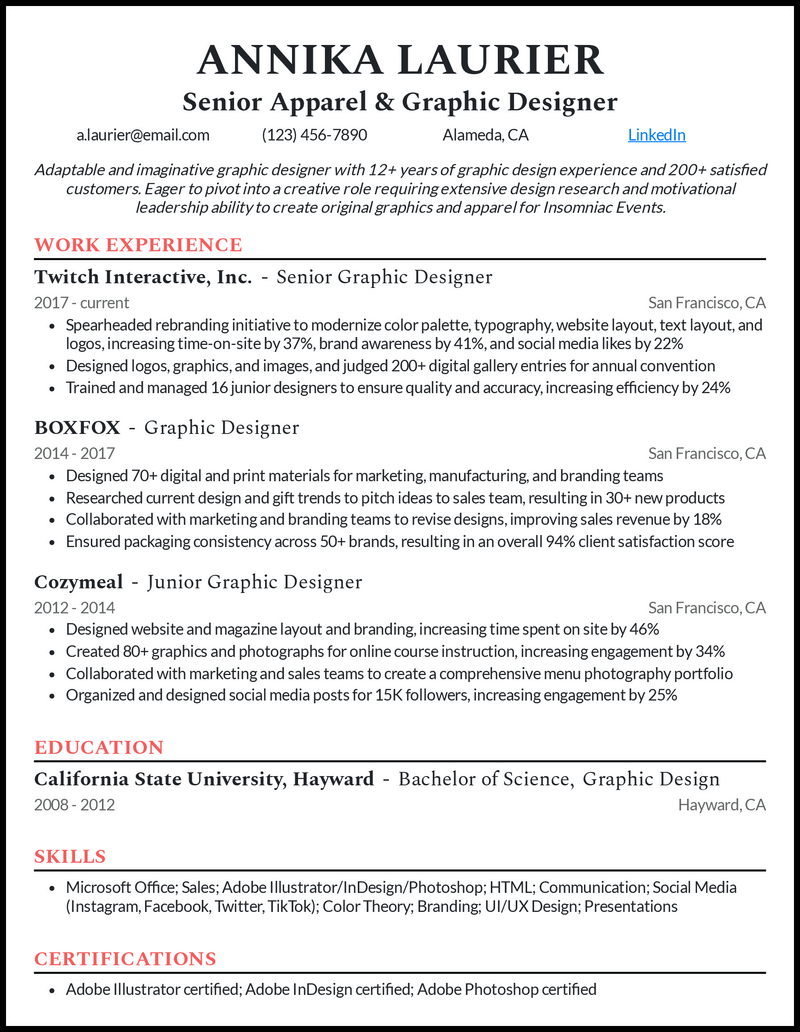

You can whip up a new logo in a flash, your friends turn to you when they need help with Photoshop, and you’re always doodling on your notes. You’re a great graphic designer, and it shows.
But when it comes to making a resume to prove your skills (not to mention writing cover letters), employers want more than just your portfolio pieces. Plus, discussing your design skills and experience on your resume can take a lot of effort.
Our graphic designer resume examples have helped graphic designers land highly coveted jobs at companies like Stripe and Apple, so they’re an excellent place to get inspired to create your great resume.






















Graphic design is one of the most profitable professions in the freelance industry, and the position is growing more popular. Graphic designers serve as visual communicators who craft concepts using a stroke of their pen or a click of their specialized graphic design software.
Their main aim is to convey ideas to inform, inspire, or capture customers through physical and virtual art forms like words, images, and abstract elements like colors and shapes. However, graphic designers aren’t just glued to their drawing tables—they spend a lot of their time communicating with clients, customers, and other creators to ensure that their designs replicate the intended message and hit the intended audiences.
Standing out in the graphic design field isn’t easy. There are about 266,000 graphic designers already in the competitive market, and the number continues to rise. Even if you’re working on your letter of resignation email and giving your job application your best shot, you don’t want to end up in the “reject pile” because of your resume.
The best way to increase your chances of getting hired is with an AI resume builder. You can showcase your skills, explain your experience, and quantify your impact in a way your portfolio can’t.
When it comes to your graphic designer resume, we’ve got four critical tips for taking your resume from the trash bin to the top choice. When you understand the role of your skills section, resume formatting, metrics, and customization, you’ll be well on your way to landing your next job.
Most recruiters don’t have time to go through the nitty-gritty details in your graphic designer resume. They have only seconds to spare, which they’ll likely use to examine your resume’s list of skills and determine whether or not they’re relevant to their needs.
Recruiters aren’t the only ones you have to impress; when recruiters have a stack of resumes to weed through, they depend on an applicant tracking system (ATS) to filter out resumes lacking keywords—skills relevant to the specific job.
That’s why the skills section of your graphic designer resume is vital. Because graphic design jobs can differ greatly in duties and requirements, your skills section should reflect your knowledge and abilities in relation to the company or organization. If you properly showcase your various skills, you can easily beat the ATS.
We don’t recommend adding more than 10 skill keywords to your skills section, but there’s still plenty of room to catch an employer’s eye. Here are some of the top hard (technical) and soft (general) skills you could include in your graphic designer resume:
![]()
Your resume is more than just your relevant experience, employment history, education, and skills; it also serves as a marketing tool. Recruiters only spend seconds looking at a given resume and tend to pass over the boring or generic ones. They want to see your unique accomplishments and the value you can provide to their company.
This is a direct ticket to an interview. That’s why you should ensure your resume reveals the best you possible. As such, you’ll want to choose the right resume format for your graphic designer resume. While many job seekers choose skills-based or hybrid-based formats, it’s almost always best to choose a reverse-chronological format. Employers can hone in on your most recent and relevant experience, letting your most relevant accomplishments and achievements shine.
1. Fixing up your resume’s appearance:
2. Meeting organization and technical requirements:
Speaking of an objective/summary, perhaps you’re wondering whether you need one in your graphic designer resume. First, let’s explain the difference between the two.
A summary is a two-to-three-sentence statement that summarizes your skills, work experience, and any specializations. It’s best used when someone has been in graphic design for 10+ years.
On the other hand, an objective is a two-to-three sentence statement that introduces your interests, qualifications, and how you’ll add value to the role you’re seeking. A resume objective is best used for career changers or entry-level job candidates.
The two are very similar, so it’s less important to understand the difference between them and more important that you pay attention to what you write for them. Vague statements and generalizations waste your and the recruiter’s time, so if you’re in doubt or are struggling to get it right, exclude it altogether.
If you’re a graphic designer looking for an entry-level position, an objective can specifically emphasize personal qualities and skills. To get the recruiter’s attention, mention the company by name and share how you intend to contribute to your desired company:

![]()
Clients and customers appreciate your designs, but it can be tricky to link graphic design to business growth. Don’t gloss over metrics, though; they’re worth the extra effort.
Design can become a key contributor to success, but only if you demonstrate how design is related to growth. There are various ways you can measure your impact on your graphic designer resume:
You may be thinking, “that’s great, but how do you translate that into a resume?” Our samples can provide some worthwhile inspiration, as seen here:

![]()
For every graphic design job you apply for, you need to tailor your resume accordingly. Customizing your graphic designer resume not only demonstrates competency but also care and attention towards the employer and the specific position. Trust us: there aren’t many job seekers taking the extra time to tailor their resumes accordingly, so make yours unique by tailoring your skills, work experience, and objective/summary sections for every job.
![]()
By taking your graphic designer resume seriously, you’ll be far ahead of the average applicant and much closer to accepting a job offer.
Now it’s time to put the pedal to the metal and actually write your resume. Upload an old resume or start from scratch with our free resume maker. You can choose from our best resume templates for an attractive and ATS-friendly layout that’s sure to snag the attention of recruiters.
Your dream job is just around the corner, so get your resume in tip-top shape and land the job you’ve been waiting for!